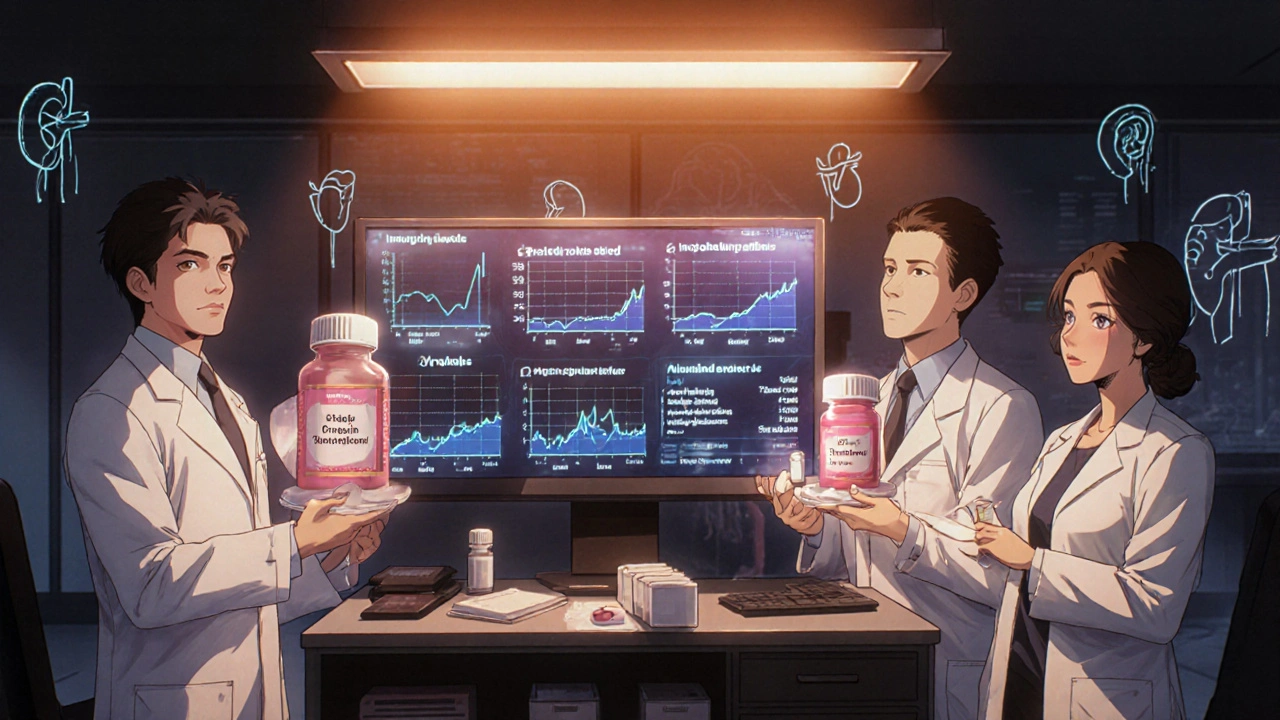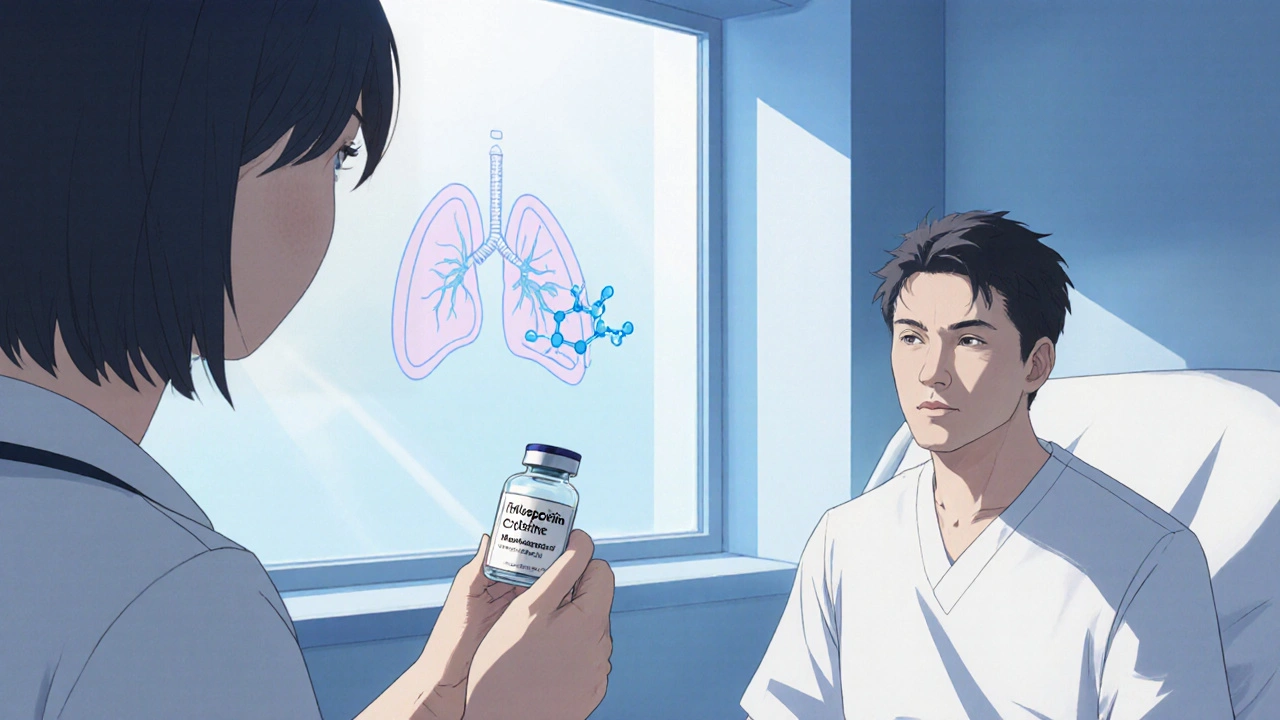Immunosuppressant Selection Advisor
Find Your Best Option
Answer a few questions about your transplant type, health conditions, and monitoring preferences to get a personalized recommendation.
Key Takeaways
- The choice between Imusporin and its alternatives hinges on the transplant type, side‑effect tolerance, and monitoring convenience.
- Calcineurin inhibitors (Imusporin, Tacrolimus) are potent but can cause kidney issues; non‑calcineurin options lower that risk.
- Cost and insurance coverage vary widely; generic forms of Cyclosporine are usually cheapest.
- Combination regimens (e.g., Imusporin + Mycophenolate) often give better protection with lower individual doses.
- Regular lab tests (creatinine, blood levels, lipids) are essential for any immunosuppressant.
What Is Imusporin (Cyclosporine)?
When talking about post‑transplant medication, Imusporin (generic name Cyclosporine) is a calcineurin inhibitor used to suppress the immune system and prevent organ rejection.
First approved in the early 1980s, Imusporin quickly became the backbone of kidney, liver, and heart transplant protocols. Its broad adoption owes to a well‑understood dosing curve and a long track record of efficacy.
How Does Imusporin Work?
Calcineurin is an enzyme that activates T‑cells, a key driver of graft rejection. By binding to cyclophilin, Imusporin blocks calcineurin’s activity, halting the transcription of interleukin‑2 and other cytokines. The result is a dampened immune response that lets the transplanted organ survive.
This mechanism is powerful but not selective; it also affects other immune cells, which explains why kidney toxicity and hypertension are common side effects.
Common Clinical Uses
Beyond solid‑organ transplants, Imusporin is used for:
- Severe psoriasis
- Rheumatoid arthritis (when other DMARDs fail)
- Certain ocular inflammatory diseases
In transplant medicine, Imusporin is typically paired with a second drug-often Mycophenolate mofetil or steroids-to achieve a synergistic effect while keeping each dose lower.
Major Alternatives Explained
Tacrolimus is another calcineurin inhibitor that’s often positioned as a stronger alternative to Cyclosporine.
Mycophenolate mofetil (MMF) works by inhibiting the proliferation of T‑ and B‑lymphocytes, offering a non‑calcineurin‑based option.
Azathioprine is an antimetabolite that interferes with DNA synthesis, used in combination regimens.
Everolimus belongs to the mTOR inhibitor class, providing a different mechanism of action.
Sirolimus (also known as rapamycin) shares the mTOR pathway target with Everolimus.
Each of these drugs brings its own balance of efficacy, side‑effect profile, and monitoring demands. Below we break down the most relevant attributes.
Side‑Effect Profiles at a Glance
Understanding the safety landscape helps clinicians match a drug to a patient’s health background.
- Imusporin: nephrotoxicity, hypertension, hirsutism, gum hyperplasia.
- Tacrolimus: similar nephrotoxicity but higher risk of diabetes and neurotoxicity.
- Mycophenolate mofetil: gastrointestinal upset, bone‑marrow suppression, increased infection risk.
- Azathioprine: liver enzyme elevation, myelosuppression, increased skin cancer risk.
- Everolimus/Sirolimus: hyperlipidemia, delayed wound healing, mouth ulcers.
Comparison Table
| Attribute | Imusporin (Cyclosporine) | Tacrolimus | Mycophenolate Mofetil | Azathioprine | Everolimus / Sirolimus |
|---|---|---|---|---|---|
| Drug class | Calcineurin inhibitor | Calcineurin inhibitor | Antiproliferative (IMPDH inhibitor) | Antimetabolite | mTOR inhibitor |
| Typical dose (adult) | 3‑5 mg/kg/day divided BID | 0.1‑0.2 mg/kg/day divided BID | 1‑1.5 g/day divided BID | 1‑2 mg/kg/day | 0.75‑1.5 mg/day (single dose) |
| Onset of action | 24‑48 hrs | 12‑24 hrs | 1‑2 weeks | 2‑4 weeks | 1‑2 weeks |
| Therapeutic monitoring | Blood trough level (100‑400 ng/mL) | Blood trough level (5‑15 ng/mL) | None routinely required | Complete blood count, LFTs | Blood trough level (5‑15 ng/mL for Everolimus) |
| Common side effects | Nephrotoxicity, hypertension | Nephrotoxicity, diabetes | Diarrhea, leucopenia | Liver toxicity, cytopenias | Hyperlipidemia, delayed wound healing |
| Average annual cost (US$) | ~$2,200 (generic) | ~$5,500 (brand) | ~$3,800 | ~$1,200 | ~$7,000 |

Choosing the Right Immunosuppressant
Decision‑making blends three pillars: efficacy, safety, and practicality.
- Efficacy: All five agents prevent acute rejection, but calcineurin inhibitors (Imusporin, Tacrolimus) have the strongest data for early‑post‑transplant periods.
- Safety: If a patient has pre‑existing kidney disease, a non‑calcineurin option like Mycophenolate or an mTOR inhibitor may spare renal function.
- Practicality: Imusporin’s generic status keeps cost low, while Tacrolimus often requires brand‑only dispensing. Frequency matters too-Imusporin is usually twice daily; Everolimus is once daily.
In many centers, a “triple therapy” approach-low‑dose Imusporin + Mycophenolate + steroids-balances potency with tolerability. When steroid side effects become a concern, switching to Tacrolimus or an mTOR inhibitor can reduce the steroid load.
Monitoring and Follow‑Up
Regardless of the chosen drug, routine labs are non‑negotiable.
- Imusporin & Tacrolimus: trough levels every 3‑7 days during the first month, then monthly.
- Renal function (creatinine, eGFR) weekly for the first 2 months, then quarterly.
- Lipid panel for mTOR inhibitors every 3 months.
- Complete blood count for Mycophenolate and Azathioprine monthly.
Patients should report any new swelling, excessive urination, or unexplained weight gain promptly-these can signal early kidney stress.
Frequently Asked Questions
Can I switch from Imusporin to Tacrolimus after a year?
Yes, many transplant programs allow a conversion once the patient is stable. The switch usually involves a gradual taper of Imusporin while introducing low‑dose Tacrolimus, with close monitoring of blood levels and kidney function.
Is the generic version of Imusporin as effective as the brand?
Clinical studies from 2023‑2024 confirm bio‑equivalence between generic Cyclosporine and brand formulations. The key is maintaining therapeutic trough levels, which depends more on adherence than on brand name.
What if I develop high blood pressure on Imusporin?
Hypertension is a common side effect. First‑line management includes lifestyle changes and an ACE inhibitor or ARB. If pressure remains uncontrolled, the physician may lower the Imusporin dose or switch to Tacrolimus, which sometimes has a milder hypertensive effect.
Are there food interactions with Imusporin?
High‑fat meals can increase absorption, leading to higher trough levels. It’s best to take Imusporin consistently-either with food or on an empty stomach-and inform the lab when dietary habits change.
Which alternative is preferred for patients with a history of skin cancer?
Azathioprine has a known link to skin malignancies, so it’s avoided. mTOR inhibitors (Everolimus, Sirolimus) also increase skin cancer risk, making Mycophenolate mofetil the safer bet for those patients.
Bottom Line
The right immunosuppressant isn’t a one‑size‑fits‑all answer. Imusporin offers a proven track record and low cost, but its kidney‑related side effects may push clinicians toward Tacrolimus or a non‑calcineurin partner. By weighing organ type, comorbidities, insurance coverage, and monitoring capabilities, providers can craft a regimen that safeguards the graft while keeping the patient’s quality of life in check.



15 Comments
Lisa Franceschi October 23, 2025 AT 22:50
Thank you for the comprehensive overview of Imusporin and its alternatives; the table succinctly captures the pharmacologic distinctions that clinicians must weigh when individualizing therapy.
Joey Yap October 25, 2025 AT 02:36
I appreciate the balanced presentation of efficacy versus safety; it reminds us that when a patient’s renal function is already compromised, a non‑calcineurin option can preserve quality of life without sacrificing graft protection.
Sean Thomas October 26, 2025 AT 05:23
Everyone seems to trust the pharma‑driven data, yet it’s worth noting that many of those “generic” Cyclosporine batches are produced by subsidiaries with undisclosed supply chains, which could influence the observed nephrotoxicity rates.
Kristin Violette October 27, 2025 AT 09:10
The mechanistic detail about cyclophilin binding is spot‑on; however, clinicians should also monitor for the downstream activation of the MAPK pathway, which can exacerbate hypertension in susceptible individuals.
Theo Asase October 28, 2025 AT 12:56
While the article is thorough, it glosses over the fact that Tacrolimus, despite its higher cost, offers a more favorable therapeutic index for patients with a familial predisposition to dyslipidemia – a nuance lost in the generic‑cost narrative.
Diane Larson October 29, 2025 AT 16:43
Building on the point about drug interactions, it’s also prudent to counsel patients that grapefruit juice can increase Cyclosporine levels by inhibiting CYP3A4, potentially pushing trough concentrations into the toxic range.
Michael Kusold October 30, 2025 AT 20:30
Good recap.
Jeremy Lysinger November 1, 2025 AT 00:16
Totally agree with the food‑interaction tip – staying consistent with meals helps keep levels stable.
Nelson De Pena November 2, 2025 AT 04:03
One of the most valuable aspects of transplant pharmacotherapy is the capacity to fine‑tune dosing based on pharmacokinetic monitoring, and this principle applies across the entire spectrum of agents discussed. First, therapeutic drug monitoring (TDM) for calcineurin inhibitors provides a quantitative window into patient adherence and metabolic variability. Second, the inter‑patient variability in CYP3A5 expression means that two patients on identical doses can have dramatically different trough levels, necessitating personalized adjustments. Third, the timing of blood draws relative to the last dose is critical; sampling too early can underestimate exposure, while sampling too late can over‑estimate it. Fourth, clinicians should be vigilant for drug–drug interactions, especially with azole antifungals and macrolide antibiotics, which can raise tacrolimus or cyclosporine concentrations. Fifth, the impact of genetic polymorphisms, such as CYP3A5*3, should be considered when interpreting levels and deciding on dose escalation. Sixth, renal function trends must be correlated with drug levels to distinguish nephrotoxicity from other causes of creatinine rise. Seventh, lipid panels should be reviewed regularly for patients on mTOR inhibitors, as hyperlipidemia can develop within weeks. Eighth, bone mineral density monitoring is advisable for long‑term corticosteroid exposure in triple therapy regimens. Ninth, patient education on consistent dosing times cannot be overstated; missed doses can precipitate acute rejection. Tenth, the psychosocial context, including health literacy, influences adherence and thus drug exposure. Eleventh, switching between agents, such as from cyclosporine to tacrolimus, requires overlapping monitoring to avoid gaps in immunosuppression. Twelfth, newer formulation technologies, like melt‑dose tablets, aim to reduce variability but still require TDM. Thirteenth, insurance coverage can affect the ability to obtain the most appropriate formulation, making cost‑effective monitoring essential. Fourteenth, emerging biomarkers, such as donor‑derived cell‑free DNA, may eventually complement traditional TDM. Fifteenth, a multidisciplinary approach involving pharmacists, transplant surgeons, and nephrologists optimizes outcomes. Lastly, ongoing research continues to refine target ranges, underscoring the dynamic nature of immunosuppressive management.
Wilson Roberto November 3, 2025 AT 07:50
The ethical dimension of suppressing the immune system raises profound questions about the balance between patient autonomy and medical paternalism, especially when lifelong therapy is mandated.
Narasimha Murthy November 4, 2025 AT 11:36
While the data presented are accurate, the article fails to address the potential bias introduced by industry‑funded trials that predominantly compare brand‑name tacrolimus to generic cyclosporine, possibly skewing perceived efficacy.
Shermaine Davis November 5, 2025 AT 15:23
Great write‑up! I learned a lot about the different side effects.
Nicholai Battistino November 6, 2025 AT 19:10
Imusporin remains a solid choice for many patients.
Suraj 1120 November 7, 2025 AT 22:56
The push for newer, pricier immunosuppressants seems more about pharmaceutical profit than genuine patient benefit, and it’s high time the transplant community demanded transparent cost‑effectiveness analyses.
Shirley Slaughter November 9, 2025 AT 02:43
Indeed, the financial incentives can cloud clinical judgment; patients deserve clear, unbiased information to make informed choices about their lifelong therapy.